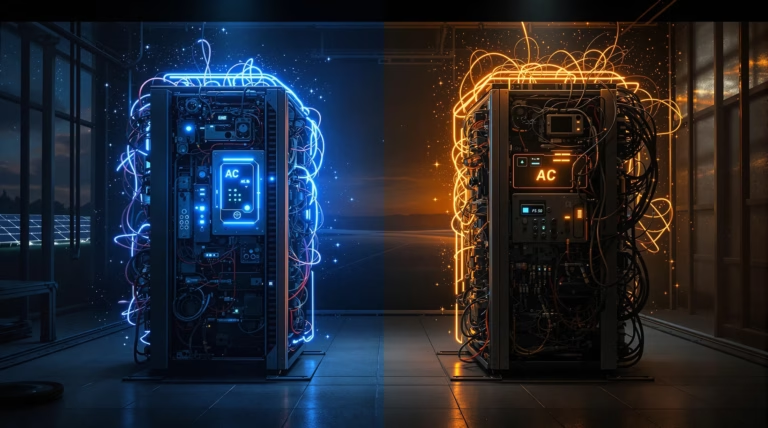Solar Generator vs Power Station: Key Differences Explained
Looking to power your devices off the grid but confused about whether to choose a solar generator or a portable power station? While these devices might seem similar, they serve distinct purposes and offer different advantages. Let’s explore their key features and help you make an informed decision for your power needs.
Understanding Solar Generators and Power Stations
Both devices provide on-demand electricity but differ significantly in their core functionality and design approach. Solar energy systems have gained prominence among sustainability enthusiasts, while portable power stations offer versatile charging solutions for various scenarios.
What is a Solar Generator?
A solar generator is an integrated power system that converts sunlight into usable electricity through photovoltaic cells. These systems comprise three essential components:
- Solar panels for capturing solar energy
- Battery storage system for power retention
- Inverter for DC to AC power conversion
What sets solar generators apart is their MPPT (Maximum Power Point Tracking) technology, which optimizes energy collection even in suboptimal conditions, ensuring reliable performance for both daily use and emergencies.
What is a Portable Power Station?
A portable power station functions as a high-capacity battery pack in a compact, mobile unit. These devices offer multiple charging options:
- Wall outlets (AC power)
- Car chargers (DC power)
- Compatible solar panels (sold separately)
- Various output ports (USB, AC, DC)
Key Differences Between Solar Generators and Power Stations
| Feature | Solar Generator | Portable Power Station |
|---|---|---|
| Primary Function | Energy generation and storage | Energy storage only |
| Power Source | Solar energy | Multiple charging options |
| Portability | Bulkier due to components | Compact and lighter (10-30 pounds) |
Energy Generation vs. Energy Storage
Solar generators actively produce electricity through integrated solar panels, creating a self-sustaining power ecosystem. In contrast, portable power stations function as sophisticated battery banks, relying on external power sources for recharging.
Portability and Versatility
Portable power stations excel in mobility with their compact design and ergonomic features. While solar generators are bulkier, they offer unmatched independence in remote locations through modular designs that allow system scaling based on power requirements.
Charging Methods and Options
Solar generators and power stations differ fundamentally in their charging approaches. Solar generators primarily rely on photovoltaic panels for power generation, offering true energy independence but requiring favorable weather conditions. Advanced models incorporate MPPT (Maximum Power Point Tracking) controllers to optimize solar collection even in less-than-ideal conditions, though sunlight dependency remains their defining characteristic.
Portable power stations excel through their charging versatility, offering multiple input options:
- Standard wall outlets (fastest charging method)
- Car charging ports for on-the-go power
- Compatible solar panels (typically sold separately)
- Fast-charging technology (80% capacity in under an hour with AC power)
- Multiple charging ports for simultaneous device charging
Components and Technology in Solar Generators and Power Stations
While these devices may appear similar externally, their internal architecture reveals distinct design philosophies. Solar generators create a complete renewable energy ecosystem, whereas power stations focus on versatile energy storage solutions. These fundamental differences in component integration directly influence performance, reliability, and user experience.
Role of Photovoltaic Cells
Photovoltaic cells serve as the cornerstone of solar generator systems, converting sunlight directly into electricity through the photovoltaic effect. These semiconductor devices generate electric current when struck by photons, with efficiency rates typically ranging from 15-22% in consumer products.
| Technology Feature | Benefit |
|---|---|
| Monocrystalline Silicon Cells | Superior efficiency and reliability |
| MPPT Technology | Optimal energy harvest in varying conditions |
| Dynamic Power Adjustment | Efficient operation during cloudy days |
Importance of AC Inverters and DC Charge Controllers
The AC inverter transforms stored DC electricity into AC power, essential for powering household devices. Premium models feature pure sine wave inverters, delivering clean electricity suitable for sensitive electronics and medical equipment.
The DC charge controller manages power flow between solar panels and batteries, providing critical protection against:
- Overcharging scenarios
- Over-discharging risks
- Potentially damaging power surges
- Temperature fluctuations
- Irregular current levels
Choosing the Right Solution for Your Needs
Selecting between a solar generator and portable power station requires careful consideration of your specific power requirements and usage patterns. Consider factors such as energy consumption, sunlight availability, and whether you prioritize renewable energy or charging flexibility.
Considerations for Off-Grid Living
For off-grid enthusiasts, solar generators often prove ideal due to their self-sustaining nature and renewable energy capabilities. When selecting an off-grid power solution, evaluate:
- Daily energy consumption patterns
- Local sunlight availability
- Critical device power requirements
- System expansion capabilities
- Long-term cost benefits
Evaluating Energy Capacity and Usage
Understanding your power requirements is essential for selecting an appropriate energy solution. To calculate your daily power needs:
- Identify the wattage of each essential device
- Multiply device wattage by hours of intended use
- Sum up all calculations to get total watt-hours (Wh)
- Add 20-30% buffer for system inefficiencies
- Consider peak power demands for simultaneous device operation
| Device Example | Wattage | Hours of Use | Daily Wh Required |
|---|---|---|---|
| Laptop | 60W | 5 | 300Wh |
| LED Light | 10W | 8 | 80Wh |
For battery storage capacity, consumer models typically range from 500Wh to over 2000Wh. Choose a system that exceeds your calculated needs by at least 20-30% to account for efficiency losses and battery degradation over time.
User Insights and Community Feedback
Real-world user experiences reveal distinct advantages for both power solutions. Solar generators prove particularly valuable in sustained off-grid scenarios, where their renewable energy generation capabilities justify the higher initial investment.
- Solar generators excel in providing energy independence during extended outdoor adventures
- Charging times require realistic expectations – typically 8-10 hours of optimal sunlight
- Portable power stations offer superior versatility for situations with multiple charging options
- Established brands consistently receive higher ratings for durability and performance
- Usage patterns should guide purchase decisions rather than maximum capacity specifications
Community feedback emphasizes the importance of matching power solutions to specific usage scenarios, with many users recommending portable power stations as ideal entry-level investments before transitioning to comprehensive solar setups.







